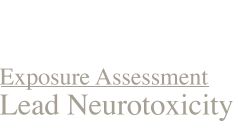 |
||||
CALENDAR |
||||||||

Risk Assessment is another type of causation: predicting whether an exposure, usually in a population rather than a single individual, will increase the risk of developing some adverse health effect, without necessarily determining whether such health effect actually occurs. Risk means that all such exposed individuals are more likely to develop an adverse effect, but it does not mean that any particular individual will or even that the majority of individuals will. Smoking, for example, increases risk of lung cancer from approximately one in 100 to 1 in 10--a signficiant increase. Nevertheless, ninety percent of smokers do not develop lung cancer, even though they are all at increased risk. Risk Assessment is used by regulatory agencies, such as the EPA, to determine how much of a chemical can be released into the environment without causing an unacceptable increase in risk of an adverse effect. 'Unacceptable' is more of a policty decision than a scientific one.
Specific causation analysis can be divided into the following three components:
(1) Hazard Assessment
(2) Exposure Assessment
(3) Health Assessment
(1) Hazard Assessment: what harm can the chemical cause, based on intrinsic toxicity and circumstnaces of exposure, form of chemical (gas, liquid, solid) and susceptibility of individual.
(2) Exposure Assessment how much of the chemical is in a media (air, water, food, soil) available to be taken into the body? Is this a one-time or multiple exposure? Does it occur over a short period of time (acute) or over many months or years (chronic)? How does the length of exposure affect the toxicity of the chemical? How much of the chemical gets absorbed into the body (dose), and where in the body does it end up (distribution and target organ/tissue)?
(3) Health Assessment: what type of health effect develops (or gets exacerbated), and does this occur immediately or after a delay (lag time)? Is this a new effect in the individual or is there a history of this type of problem, made worse by the chemical exposure? Is the individual in a high risk group (in utero, infant, elderly, reduced immune function)? Are there other (alternative) known causes for this problem and were these causes present ?
Exposure Assessment
Lanphear et al (2005) conducted a pooled analysis of 1333 children from seven studies, which produced sufficient numbers of children whose BPb had been closely monitored during the critical early childhood period and whose BPb had not exceeded certain levels at any time. The Lamphear study found two such groups: those whose BPb did not exceed 10 ug/dl and those that did not exceed 7.5 ug/dl, allowing these two distinct BPb groups to be compared with those with BPb ranging from 10 ug/dl to 30 ug/dl from shortly after birth to five years of age. IQ was also measured during this time period. They found that increases of BPb from 2.4 to 10 ug/dl caused a much greater decrement in IQ score than increases in BPb from 10 to 20 ug/dl, or from 20 to 30 ug/dl. These results confirmed an earlier study by Canfield et al (2003), that tracked BPb from infancy through five years of age, with more than half having BPb that never reached or exceeded 10 ug/dl. Canfield found that BPb increases from 1 ug/dl to 10 ug/dl resulted in a decrement of 7.4 IQ points, compared to decrements of 4.6 IQ points for each additional 10 ug/dl increase in BPb above10 ug/dl. A steeper dose response curve of BPb below, as opposed to above, 10 ug/dl, was also demonstrated in a study by Schwartz (1994).
A reanalysis of a Boston cohort by Bellinger and Needleman (2003), prompted by the Canfield results, found 48 children whose BPb had been closely monitored in early childhood and had never reached or exceeded 10 ug/dl, and they too found a steeper drop in IQ versus increases in BPb below 10 ug/dl, as compared to increases above that level. The Bellinger and Needleman reanalysis was also important because this cohort included many middle and upper middle income students. One of the questions about the steeper sub 10 ug/dl dose-adverse effect curves was whether the (detrimental) influence of other confounding factors, such as maternal IQ, stimulation of the home environment in early childhood or absence of other early educational opportunities, simply became more pronounced and apparent as the affects of very low BPb levels were reduced. Assuming such effect was solely due to BPb would create a seemingly disproportionate toxic effect of lead on IQ at those (very low) levels. The Bellinger and Needleman study, as well as other similar sub-10 ug/dl studies, suggests that these confounders were not the cause for the steeper dose response curve.
Rothenberg and Rothenberg (2005) extended these findings by applying a log linear model to these dose response relationships, rather than the usual linear model and found the log linear model fit the data better. The linear model emphasizes an absolute effect of BPb dose on toxicity, whereas a log linear model emphasizes a proportionate effect. For example, a linear model predicts that a 10 ug/dl increase in BPb (from 10 ug/dl to 20 ug/dl) exerts twice the toxicity as would a 5 ug/dl increase (from 5 ug/dl to 10 ug/dl), whereas the log linear model would predict a more proportionate increase in toxicity in each case.
The actual dose response curves fit the latter model much better than the former, and this has a number of implications. Such model not only predicts that a significant portion of low level lead toxicity occurs below 10 ug/dl, as reflected in the above studies, rather than above 10 ug/dl, but that the economic costs associated with intellectual, behavioral and other neurological deficits are more than twice previously calculated (Canfield 2003).
Lead neurotoxicity in young children affects not only intellectual development but other behavioral and social parameters, which can also greatly impact one’s success in life and the social costs of managing these problems. Needleman (2002) showed that bone lead (the lead reservoir) in young males was correlated with increased criminal behavior, anti social attitudes and other forms of juvenile delinquency. Dietrich et al (2001) showed similar effects on juvenile delinquency.
A study by Nevin (2000) shows a correlation between use of lead-based paint, as well as leaded gasoline, and both unwed pregnancy and criminality, including murder, as far back as the early 1900’s. This study also showed a steeper dose relationship between BPb below 10 ug/dl and IQ deficits, compared to above 10 ug/dl, and showed a correlation between IQ deficits and social/behavioral problems, suggesting a significant effect of lead on social behavior at very low BPb.
Whereas lead toxicity is expressed and observed early, at the time of exposure, in causing apparently irreversible decrements in intellectual and social functioning, experiments by Basha et al (2005) (suggest latent neurotoxic effect from early, transient lead exposure. Rats dosed with lead during the first twenty days of life exhibited elevated BPb, characteristic of lead poisoning, which subsequently returned to normal post dosing. During the dosing period, APP mRNA also showed increased activity during the neonatal period of increased BPb, which also returned to normal. But in old age APP mRNA again became active, accompanied by excessive amounts of APP (B-amyloid precursor protein), the protein from which B-amyloid deposits are derived in the brain. These deposits are characteristics of brains in Alzheimer’s patients. In older rats not dosed in early life but dosed for two months in old age, no such increase in APP m-RNA, APP or B-amyloid was found, suggesting that early lead exposure can not only produce permanent tissue damage with significant life long effects, but program alterations in gene expression which can cause significant effects later in life.
